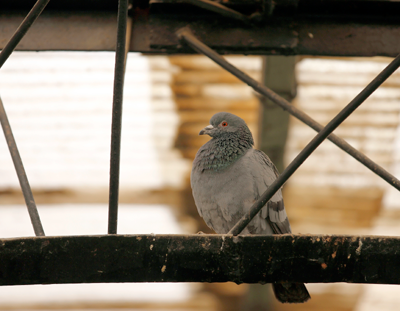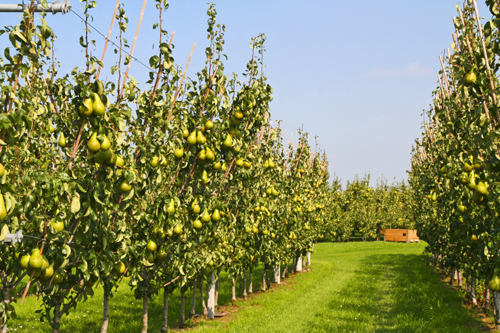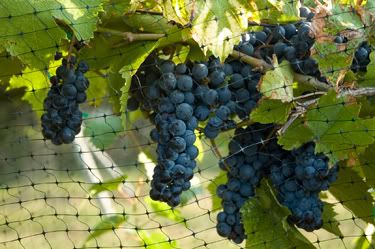
by Alex Kecskes
If your home has a separate garage or shed, you probably have pest birds roosting and nesting either inside or under the eaves. Birds love to perch on the rooftops and exposed beams of these structures. And unless you deter them with some bird control device, birds will continue to gather in greater numbers in and around these structures. Eventually, birds will even start to nest and roost under the eaves of your home.
The longer you wait to implement some effective bird control measures, the more brazen the birds will become. They’ll start to gather in your back yard and leave droppings all over your pool, spa, patio, and BBQ. Keep in mind that birds can carry any of 60 known diseases. If you have children or pets, you’ll be cleaning up the bird droppings on a daily basis.
The good news is that there are a number of humane and effective bird deterrents that you can use. Here are a few that you should look into:
Garden Bird Netting
Lightweight and easy to handle, Garden Mesh Netting will block birds from specific nesting sites around your shed or garage. It comes in 14 x 100-foot and 14 x 200-foot rolls, but you can easily cut it down to the size. It’s also available in three different "mesh" sizes--1/4" mesh, 1/2" mesh and 3/4" mesh. It’s easy to install under eaves and other areas, especially if you use the bird netting clips that are recommended. The netting is made from a durable, UV-protected polypropylene. It’s strong, lightweight and virtually invisible.
Bird Slope
Scientifically designed to keep pest birds away from eaves and similar nooks and crannies, Bird Slope are slippery PVC panels that mount under eaves to prevent birds from gaining a foothold. They scramble and “squirrel-cage” with their little toes and finally give up, moving on to other more hospitable areas. The best bird slope panels are UV protected and sun- and weather-resistant to last longer. Bird slope is ideal for deterring a wide range of birds—including swallows, starlings, pigeons and seagulls. The panels blend in with most architectural styles and they’re now available in two colors--stone and grey.
Copper Stuf-Fit Mesh
Ideal for keeping pest birds out of small holes and crevices, Copper Stuf-Fit mesh creates a physical barrier that blocks out birds. It’s ideal for use in openings and tight spaces too small for regular netting or other products. The mesh comes in 20-foot and 100-foot roles and can be “formed” into the shape of the area needed to deny birds access. The wire mesh will hold its shape in tight areas to prevent birds from “working” their way around it. It can also be used to block birds from getting under roofing tiles, retractable awnings, and where pipes enter siding or foundations.
No Nasty Nest
Ideal for use in blocking swallows, No Nasty Nest consists of hanging "twine" that denies birds access to nesting sites. Faced with wading through the twine strips, birds will simply move on to a better spot to nest. If you have swallow mud nests under the eaves and sides of your garage, shed or home, you’ll want to get this bird deterrent. Each strip of No Nasty Nest has a self-adhering back for fast application on eaves, gables, entryways and other areas.

by Alex A. Kecskes
A beautiful garden can be a joy to behold. It reflects the hours of work and care you put into it—the feeding and weeding and spraying for bugs. But unless you exercise some form of effective bird control, your well-tended garden can quickly be ruined by pest birds. Vegetable and fruit gardens are particularly vulnerable. While a few songbirds can add a certain ambiance to a garden, gathering flocks of birds—like crows, pigeons, finches—can destroy ripening fruit and vegetables. They can leave droppings everywhere, turning your garden into a smelly, disease-carrying mess.
The only way to protect your garden is with proven effective bird deterrents. And the best way to ensure your garden won’t be attacked by flocks of pest birds is to implement these bird deterrents before your fruits and vegetables ripen.
Here are three of today’s most popular and effective pest bird deterrents:
Plastic Bird Netting
Creating a physical barrier that denies birds access to specific areas of your garden, Plastic Bird Netting offers a humane, low profile bird deterrent. The netting usually comes in 14 x 100-foot and 14 x 200-foot rolls and three different mesh sizes. There’s a 1/4-inch mesh for smaller birds and a 1/2-inch mesh and a 3/4-inch mesh for larger birds. The best plastic bird netting is fabricated from durable, U.V.-protected polypropylene. This netting is strong, light, easy to handle and virtually invisible.
Install bird netting before your garden bears fruit or vegetables. Suspend the netting over your bushes or vines by at least 6 inches. Protect vegetables by wrapping individual plants in netting or suspend the netting around an entire garden area. To safeguard fruit trees, measure the circumference of the tree and cut the net to size (allow at least one foot extra around the circumference). Secure the netting with twine, zip ties, or hog rings.
Sonic Bird Deterrents
These devices broadcast bird distress and predator calls that make birds feel too uneasy to stay in your garden. The sounds resemble normal bird sounds, so they won’t irritate your pets, friends or neighbors. One highly versatile sonic system can emit distress and predator calls for 22 different species of birds. This unit covers up to an acre of land and can be programmed to turn on or off at night.
Visual Bird Deterrents
Ideally, you would want to use Visual Bird Deterrents in conjunction with the two deterrents mentioned above. These consist of Flash Tape and Reflective Banners, which reflect sunlight and snap in the breeze to make birds too nervous to feed. Also included in this category are Scare Eye Diverters and Bird Scare Balloons—both feature large predator eyes to intimidate pest birds. Visual bird deterrents attach easily to patio covers, gazebos, tree branches, or any elevated area in your garden. Just remember to move them around frequently to convince birds they are “live” threats.

by Alex A. Kecskes
As a homeowner, you know that pest birds can cause considerable damage to your garden. Fruits are especially vulnerable and can be quickly ruined by even a few birds.
Today, 95 percent of all American gardens grow tomatoes. One woman in North Texas suffered extensive damage to her tomato plants by mockingbirds. As soon as her tomatoes got red, ripe and ready to pick, the birds would take bites out of them. They would continue to nibble on her tomatoes all day long. A great-looking tomato, almost ready to pick in the morning, would be ruined with bite marks by late afternoon. Effective pest bird deterrents would have saved her tomatoes.
A sure sign that birds are attacking your fruit is the presence of holes throughout. Starlings and blackbirds can eat the fruits and vegetables you worked so hard to grow. Canada geese will munch on your grass and leave nearly a pound a day (per goose) of droppings. Birds can also damage your favorite trees. They’ll rip through bark searching for bugs. Few plants are safe from pest birds. They’ll use their beaks to rip, tear and tug your plants pieces.
The temptation is to resort to lethal bird control measures—like BB guns and poisons (avicides). But if you have pets or children, these methods are highly undesirable as well as being inhumane to birds. Fortunately, there are a number of bird deterrents on the market that are both effective and humane. They’re ideal for keeping pest birds out of your garden. Here are three proven bird control measures:
Lightweight Plastic Bird Netting
Plastic bird netting lets you exclude pest birds from garden, enclosed courtyard, patio or similar area. The netting comes in various mesh sizes to block out pigeons, sparrows, starlings, seagulls and other birds. The best high quality bird netting is available in various colors to blend in with your garden’s décor. One manufacturer offers a bird netting kit for fast, easy installation. The kits include perimeter cable, cable crimps, turnbuckles, intermediate attachments, hog rings, and accessories and tools.
Sonic Deterrents
These devices generate distress and predator calls that make birds too scared to hang around and feed. One commercially available system can generate such calls for 22 different species of birds. The calls, repeated every 10 minutes, resemble natural birdcalls to humans and won’t irritate pets. You can set a volume control to generate from 65-105 decibels, and you can program the unit to turn on or off at night. The best bird sonic units come with a built-in speaker that protects gardens up to an acre.
Bird Scare Deterrents
These inexpensive bird deterrents create an “Optical Distraction Zone” that makes pest birds too nervous to hang around your garden. They consist of reflective foils, shiny tape banners and balloons that are easy to install. Some balloons have giant predator eyes to give birds that “spied on” feeling. Balloons can also be filled partially with water to skim the surface of swimming pools, spas and Koi ponds.

by Alex A. Kecskes
If your home has been besieged by gulls, you know what a nuisance they can be. These scavengers will eat just about anything that’s on your patio, boat dock or backyard. That includes fish, insects, mollusks, worms, mice, young birds, bird eggs, and berries. When gulls feast and gather, they'll leave an awful mess. They can cover your backyard and patio area with smelly, disease carrying droppings and rotting fish. If they use your rooftop to tear apart their prey, they can dislodge and damage roofing tiles and other rooftop structures.
Like most birds, it’s not just one type of gull you have to worry about. There are over 45 species of gulls. Your typical gull is a medium to large bird with a mostly white body and grey or black markings on the wings and tail. Their stout, orange bills and webbed feet make them easily recognizable. While gulls are often found near large bodies of water like bays, inlets and lakes (as well as the ocean), they have been known to venture inland for food. So don’t be surprised to see them on the roof of your home or patio if your home is miles inland.
To keep gulls away from your home, you should first remove any open food source such as open trashcans or pet food. After that, you’ll need some effective bird control measures to keep them away. Here are three bird deterrents the pros use:
Bird Spikes for Gulls
Gulls regularly choose the roof of a home or structure to roost on. The peak of a roof is an especially desired area as it provides a nice look out point for food and predators. Bird Spikes are a humane product used to keep gulls off roof lines, parapet walls, pilings and other areas. Bird Spikes simply create an uneven surface that gulls know they cant land on. Spikes that are pre-assembled, such as the Stainless or Plastic versions are easiest to install.
Bird Spiders
Bird Spiders have spindly arms that whip about in the wind. Gulls see these and will simply move on to a friendlier landing perch. Bird Spiders are easy to set up on decks, posts, atop light fixtures, rooftops, fixed umbrellas and awnings. These bird deterrents are available in 2-, 4-, 6- and 8-foot arm lengths to create larger and larger areas of bird deterrence. Look for bird spiders that feature a glue-on base, which can be attached to most surfaces.
Sonic Gull Control
No gull likes to hear his fellow gulls being attacked. Or the sound of Peregrine falcons screeching in for the kill. Bird Sonic Deterrents exploit these fears and drive gulls away. These devices broadcast prerecorded distress and predator calls that resemble normal bird sounds to humans. One popular device features a built-in speaker that covers up to one acre. The unit can be programmed to turn on or off at night, and you can even adjust the volume.
|




 RSS Feed
RSS Feed